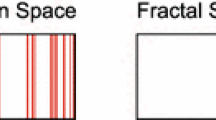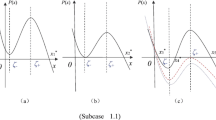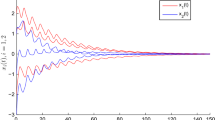Abstract
In previous paper, the number of equilibrium points of a cellular neural network (CNN) was studied. However, the region of different values of equilibrium points of every cell in the CNN is not investigated. Therefore, in this paper, the regions of the number of different values of equilibrium points in cellular neural networks (CNNs) with thresholding activation function are obtained by the relationship between parameters of CNNs. The influence of the values of connection weights of CNNs on the number of equilibrium points for a cell is found. Some sufficient conditions are obtained by using the relationship among connection weights. Depending on these sufficient conditions, inputs and outputs of a CNN, the regions of the values of parameters can be obtained. Finally, some numerical simulations are presented to support the effectiveness of the theoretical analysis.








Similar content being viewed by others
Explore related subjects
Discover the latest articles, news and stories from top researchers in related subjects.References
Chua LO, Yang L (1988) Cellular neural networks: theory. IEEE Trans Circuits Syst 35:1257–1272
Chua LO, Yang L (1988) Cellular neural networks: applications. IEEE Trans Circuits Syst 35:1273–1290
Julian P, Dogaru R, Chua LO (2002) A piecewise-linear simplicial coupling cell for CNN gray-level image processing. IEEE Trans Circuits Syst I Fundam Theory Appl 49:904–913
Grassi G, Grieco LA (2003) Object-oriented image analysis using the CNN universal machine: new analogic CNN algorithms for motion compensation, image synthesis, and consistency observation. IEEE Trans Circuits Syst I Fundam Theory Appl 50:488–499
Itoh M, Chua LO (2007) Advanced image processing cellular neural networks. Int J Bifurcation Chaos 17:1109–1150
Werblin F, Roska T, Chua LO (1995) The analogic cellular neural network as bionic eye. Int J Circuit Theory Appl 23:541–569
Chua LO, Roska T (2002) Cellular neural networks and visual computing. Cambridge University Press, Cambridge
Zeng ZG, Wang J (2009) Associative memories based on continuous-time cellular neural networks designed using space-invariant cloning templates. Neural Netw 22:651–657
Kaluzny P (1994) Number of stable equilibrium states of cellular neural networks. IEEE Trans Circuits Syst I Fundam Theory Appl 41:608–610
Zheng CD, Lu LB, Wang ZS (2009) New LMT-based delay-dependent criterion for global asymptotic stability of cellular neural networks. Neurocomputing 72:3331–3336
Xia YH, Cao JD, Cheng SS (2007) Global exponential stability of delayed cellular neural networks with impulses. Neurocomputing 70:2495–2501
Zeng ZG, Huang DS, Wang ZF (2005) Memory pattern analysis of cellular neural networks. Phys Lett A 342:114–128
Zeng ZG, Huang DS, Wang ZF (2008) Pattern memory analysis based on stability theory of cellular neural networks. Appl Math Model 32:112–121
Zeng ZG, Wang J (2008) Design and analysis of high-capacity associative memories based on a class of discrete-time recurrent neural networks. IEEE Trans Syst Man Cybern Part B Cybern 38:1525–1536
Gilli M, Biey M, Checco P (2004) Equilibrium analysis of cellular neural networks. IEEE Trans Circuits Syst I Regul Pap 51:903–912
Takahashi N (2000) A new sufficient condition for complete stability of cellular neural networks with delay. IEEE Trans Circuits Syst I Fundam Theory Appl 47:793–799
Li XM, Huang LH, Wu JH (2003) Further results on the stability of delayed cellular neural networks. IEEE Trans Circuits Syst I Fundam Theory Appl 50:1239–1242
Liao XX, Wang J, Zeng ZG (2005) Global asymptotic stability and global exponential stability of delayed cellular neural networks. IEEE Trans Circuits Syst I Express Briefs 52:403–409
Liao XX, Luo Q, Zeng ZG, Guo YX (2008) Global exponential stability in Lagrange sense for recurrent neural networks with time delays. Nonlinear Anal Real World Appl 9:1535–1557
Zheng CD, Zhang HG, Wang ZS (2009) New delay-dependent global exponential stability criterion for cellular-type neural networks with time-varying delays. IEEE Trans Circuits Syst II Express Briefs 56:250–254
Xiao SP, Zhang XM (2009) New globally asymptotic stability criteria for delayed cellular neural networks. IEEE Trans Circuits Syst II Express Briefs 56:659–663
Li CJ, Li CD, Liao XF, Huang TW (2011) Impulsive effects on stability of high-order BAM neural networks with time delays. Neurocomputing 74:1541–1550
Zeng ZG, Wang J (2006) Complete stability of cellular neural networks with time-varying delays. IEEE Trans Circuits Syst I Regul Pap 53:944–955
Zeng ZG, Wang J (2006) Improved conditions for global exponential stability of recurrent neural networks with time-varying delays. IEEE Trans Neural Netw 17:623–635
Zeng ZG, Wang J (2006) Multiperiodicity and exponential attractivity evoked by periodic external inputs in delayed cellular neural networks. Neural Comput 18:848–870
Zeng ZG, Wang J (2007) Analysis and design of associative memories based on recurrent neural networks with linear saturation activation functions and time-varying delays. Neural Comput 19:2149–2182
Han Q, Liao X, Li C (2012) Analysis of associative memories based on stability of cellular neural networks with time delay. Neural Comput Appl, published online: 20 Jan 2012
Han Q, Liao X, Weng T, Li C, Huang H (2012) Analysis on equilibrium points of cells in cellular neural networks described using cloning templates. Neurocomputing 89:106–113
Zeng ZG, Wang J, Liao XX (2004) Stability analysis of delayed cellular neural networks described using cloning templates. IEEE Trans Circuits Syst I Regul Pap 51:2313–2324
Chua LO, Roska T (1993) The CNN paradigm. IEEE Trans Circuits Syst I Fundam Theory Appl 40:147–156
Liu D, Michel AN (1993) Cellular neural networks for associative memories. IEEE Trans Circuits Syst II Analog Digit Signal Process 40:119–121
Acknowledgments
This work was supported in part by the National Natural Science Foundation of China under Grant 60973114, Grant 61170249 and Grant 61003247, in part by the Natural Science Foundation project of CQCSTC under Grant 2009BA2024, and in part by the State Key Laboratory of Power Transmission Equipment and System Security and New Technology, Chongqing University, under Grant 2007DA10512711206, in part by Teaching and Research Program of Chongqing Education Committee (KJ110401), in part by the First Batch of Supporting Program for University Excellent Talents in Chongqing, and in part by Research Project of Chongqing University of Science and Technology under Grant CK2011Z17.
Author information
Authors and Affiliations
Corresponding author
Rights and permissions
About this article
Cite this article
Han, Q., Liao, X., Weng, T. et al. Analysis on equilibrium points of cellular neural networks with thresholding activation function. Neural Comput & Applic 23, 23–29 (2013). https://doi.org/10.1007/s00521-012-1173-1
Received:
Accepted:
Published:
Issue Date:
DOI: https://doi.org/10.1007/s00521-012-1173-1




